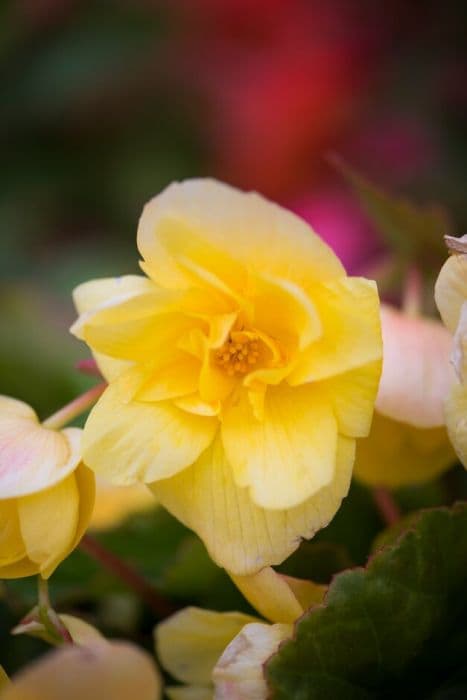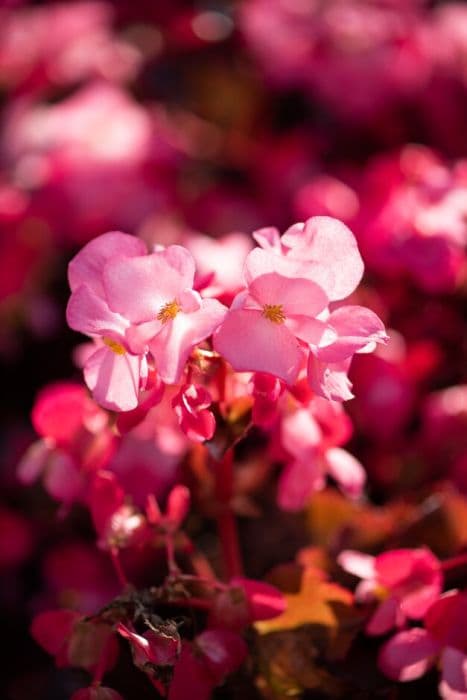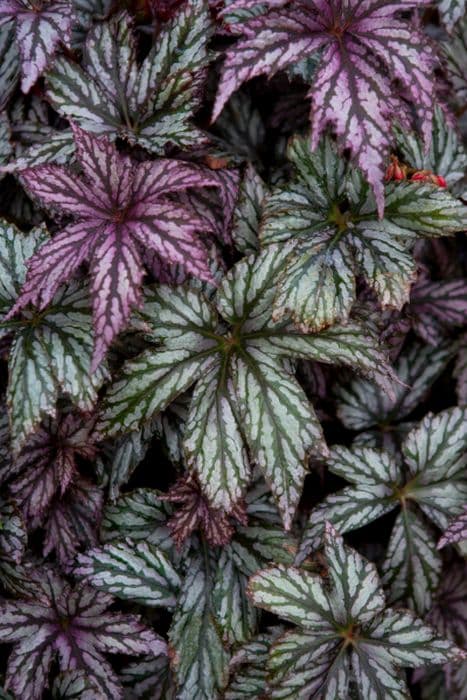Carol Flame Begonia Begonia 'Carol Flame'

ABOUT
Begonia 'Carol Flame' is a striking plant with a vibrant appearance. This plant features a lush display of foliage and flowers that capture attention. The leaves are often a rich green color, with a distinctive shape that may include pointed tips and wavy or serrated edges, adding to its ornamental appeal. What makes 'Carol Flame' stand out is its flamboyant blooms that come in a fiery shade resembling the hues of a flame, often a blend of warm colors such as reds, oranges, and yellows, which can be quite eye-catching. These flowers typically have a unique, asymmetrical form that is common among begonias, giving each bloom its own character. As for the texture, the petals can have a smooth, velvety touch which contrasts nicely against the foliage. This begonia may also exhibit a bushy growth habit, creating a full and robust presence, making it a popular choice for adding a splash of color to various settings. Overall, Begonia 'Carol Flame' is admired for its colorful and vivacious look that adds interest and warmth wherever it is grown.
About this plant
 Names
NamesFamily
Begoniaceae.
Synonyms
Wax Begonia, Bedding Begonia, Semperflorens.
Common names
Begonia 'Carol Flame'
 Toxicity
ToxicityTo humans
Begonia, including the 'Carol Flame' variety, is generally considered non-toxic to humans. However, it can cause irritation to the skin or the mouth if ingested due to crystal-like structures called calcium oxalate crystals. Symptoms of ingestion might include a burning sensation in the mouth or on the skin, swelling of the lips, tongue, or throat, and gastrointestinal discomfort such as nausea or vomiting. In most cases, symptoms are mild and can be managed by rinsing the mouth with water and taking pain relief if necessary, but if symptoms are severe or persist, medical attention should be sought.
To pets
Begonia, including the 'Carol Flame' variety, is toxic to pets, particularly cats and dogs. If a pet ingests any part of a begonia plant, they could experience symptoms such as drooling, vomiting, and difficulty swallowing due to the irritation caused by calcium oxalate crystals present in the plant. In rare cases, more severe symptoms like kidney failure could occur if large quantities are consumed. If your pet exhibits these symptoms or you suspect begonia ingestion, it is recommended to contact your veterinarian immediately.
 Characteristics
CharacteristicsLife cycle
Perennials
Foliage type
Evergreen
Color of leaves
Mixed
Flower color
Red
Height
1-2 feet (30-60 cm)
Spread
1-2 feet (30-60 cm)
Plant type
Herb
Hardiness zones
10
Native area
South America
Benefits
 General Benefits
General Benefits- Aesthetic Appeal: Adds visual interest to indoor spaces with its vibrant foliage and colorful blossoms.
- Low Maintenance: Requires minimal care, making it suitable for busy individuals or those new to gardening.
- Humidity Tolerance: Thrives in a range of humidity levels, which is beneficial for growing in various indoor environments.
- Versatility: Can be used in mixed plantings or as a standalone specimen, providing flexibility in gardening design.
- Long Blooming Period: Produces flowers for an extended period, offering consistent beauty in a living space or garden.
- Compact Growth: Its size is manageable for small spaces, such as apartments or small offices.
 Medical Properties
Medical PropertiesThis plant is not used for medical purposes.
 Air-purifying Qualities
Air-purifying QualitiesThis plant is not specifically known for air purifying qualities.
 Other Uses
Other Uses- Begonias like 'Carol Flame' can be used as a natural dye for fabrics, with petals and leaves offering a range of pink and green hues.
- The waxy leaves of Begonias can be used in crafting, such as pressed flower art, adding a splash of color to bookmarks, cards, and other paper products.
- Begonia petals can be used in potpourri mixes, contributing a subtle fragrance and bright color to the blend.
- These plants can be used for educational purposes, such as teaching botany and horticulture to students of all ages.
- Begonias can be used in photography as subjects due to their striking appearance, providing an excellent opportunity for macro and nature photography.
- They can serve as a natural indicator for humidity levels in a greenhouse, with leaves responding to changes, aiding in plant care.
- Begonias can be used in companion planting, believed to repel some pests that might otherwise attack vegetables and herbs.
- The sturdy foliage and stems of Begonias can be used in creating living sculptures or topiaries for garden design.
- Begonia plants can be part of a rain garden, utilizing their love for moisture to help manage rainwater runoff in an eco-friendly way.
- These plants can be used to add a pop of color in terrariums or fairy gardens, enhancing the aesthetic of miniature landscapes.
Interesting Facts
 Feng Shui
Feng ShuiThe Begonia is not used in Feng Shui practice.
 Zodiac Sign Compitability
Zodiac Sign CompitabilityThe Begonia is not used in astrology practice.
 Plant Symbolism
Plant Symbolism- Caution: Begonias are often associated with warnings or caution, possibly due to the poisonous nature of some species when ingested. They remind individuals to be wary in new situations.
- Individuality: The 'Carol Flame' variety, with its unique and striking appearance, could symbolize someone's distinctive personality and the importance of standing out from the crowd.
- Harmony: Begonias can represent a sense of balance and a reminder to stay level-headed. The 'Carol Flame', with its vibrant colors, exemplifies the beauty of maintaining harmony in life.
- Gratitude: Giving begonias might express gratitude. They could be offered to someone as a sign of appreciation for their help or kindness.
 Water
WaterBegonias like the 'Carol Flame' should be watered once the top inch of soil feels dry. Avoid watering too frequently, as Begonias are susceptible to root rot. Generally, this means watering every 7 to 10 days, but this can vary depending on environmental factors like humidity and temperature. When watering, use room temperature water and gently pour it around the base of the plant until excess water drains from the bottom of the pot, which might be around 16 to 24 ounces for a medium-sized pot. Always empty the saucer to ensure the plant is not sitting in standing water.
 Light
LightThe 'Carol Flame' Begonia thrives in bright, indirect light. It’s best suited to spots where it receives this kind of light for most of the day, such as near east- or west-facing windows. Direct sunlight can scorch the leaves, so it's important to avoid placing this plant in direct sun, especially during peak hours. A sheer curtain can help to diffuse strong sunlight if needed.
 Temperature
Temperature'Carol Flame' Begonias prefer a warm environment, with ideal temperatures ranging between 65 and 75 degrees Fahrenheit. They can survive minimum temperatures of 60 degrees Fahrenheit but should not be exposed to temperatures below that, as cold can be damaging. Likewise, temperatures exceeding 85 degrees Fahrenheit can cause stress to the plant, so it is best to avoid excessively hot conditions.
 Pruning
PruningPruning 'Carol Flame' Begonias is important for maintaining a bushy and attractive shape and to remove any dead or dying leaves and stems. This can be done as needed throughout the year, but the best time for heavier pruning is in the spring before new growth starts. Light pruning involves simply pinching off the tips of the stems to encourage bushiness. Always use clean, sharp scissors or pruning shears to make clean cuts.
 Cleaning
CleaningAs needed
 Soil
SoilBegonia 'Carol Flame' thrives in a well-draining soil mix that can retain some moisture but does not stay soggy. A mixture of peat, perlite, and pine bark in equal parts is ideal. The recommended soil pH range for Begonia 'Carol Flame' is slightly acidic to neutral, ideally between 5.5 and 7.0.
 Repotting
RepottingBegonia 'Carol Flame' should typically be repotted every 1-2 years or when the plant becomes root-bound. The best time to repot is in the spring or summer during the plant's active growth period.
 Humidity & Misting
Humidity & MistingBegonia 'Carol Flame' prefers a relatively high humidity level, ideally between 50% to 70%. This tropical plant thrives in moist air, so maintaining adequate humidity is crucial for its health.
 Suitable locations
Suitable locationsIndoor
Provide bright, indirect light and maintain high humidity.
Outdoor
Needs shade, warm temps, and shelter from wind.
Hardiness zone
10-11 USDA
 Life cycle
Life cycleThe Begonia 'Carol Flame', generally known as a type of Begonia cultivar, begins its life cycle from seed or more commonly from leaf cuttings or division, where it quickly takes root in moist, well-draining soil. Upon rooting, the plant enters a vigorous vegetative growth phase, sprouting broad, wing-shaped leaves that can display vibrant colors and patterns, and begins to form a bushy structure. As it matures, the plant produces clusters of flowers that can vary in color from pinks to reds, typically blooming in the warmer months given sufficient indirect light and humidity. After pollination, the flowers will produce seed capsules that, when ripened, will burst open to spread the seeds for propagation. In perennial growing zones, the Begonia 'Carol Flame' will enter a dormancy period during cooler seasons, where growth slows and the plant may lose some leaves, only to rejuvenate in the spring. With proper care, the cycle continues year after year, with regular pruning and feeding to encourage fresh growth and maintain plant health.
 Propogation
PropogationPropogation time
Spring-Summer
The Begonia 'Carol Flame', commonly referred to as simply Carol Flame Begonia, can be effectively propagated using leaf cuttings, which is the most popular method for this particular plant. To propagate by leaf cuttings, select a healthy, mature leaf and cut it into pieces, each with at least one vein. After the pieces are cut, they can be placed vein-side down on a moistened mix of peat and perlite, ensuring the cut edge is slightly buried. The container should then be covered with plastic to maintain humidity and placed in indirect light. Roots will typically develop where the leaf touches the growing medium, and once a substantial root system is formed, the new plantlets can be potted up individually.




![Begonia [Devotion]](/_next/image?url=https%3A%2F%2Fplants-admin.emdemapps.com%2Fimages%2Fplants%2F%2Fimages%2F604b58183573b.png&w=640&q=75)




![Begonia [Fragrant Falls Orange]](/_next/image?url=https%3A%2F%2Fplants-admin.emdemapps.com%2Fimages%2Fplants%2F%2Fimages%2F604b537c1a26c.png&w=640&q=75)